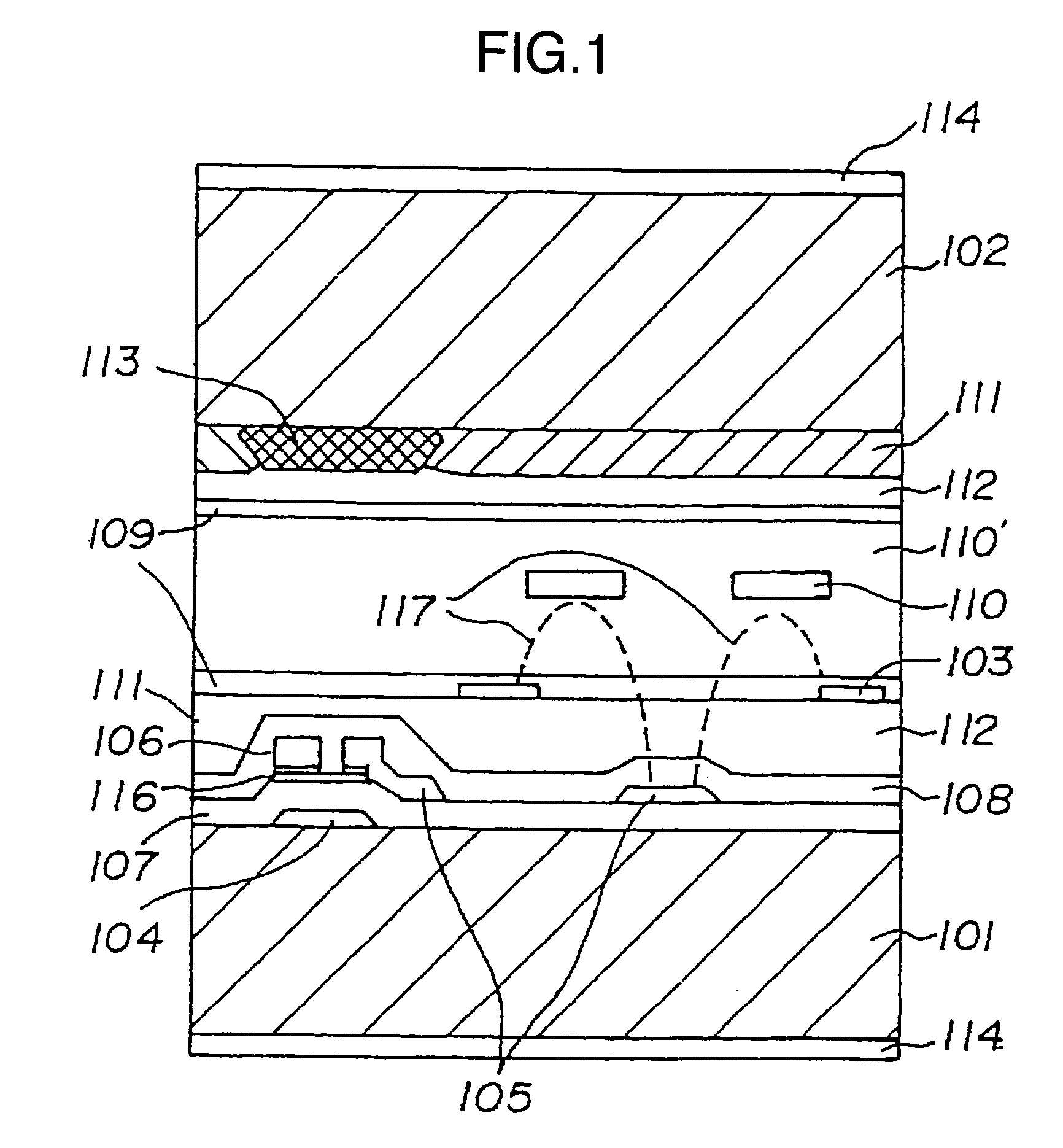Liquid crystal display and method for manufacturing same
- Summary
- Abstract
- Description
- Claims
- Application Information
AI Technical Summary
Benefits of technology
Problems solved by technology
Method used
Image
Examples
example 1
[0083] Example 1 corresponds to the liquid crystal display described in Embodiment 1 of the present invention explained above. Detailed description will hereinafter be made for Example 1 of the present invention with reference to FIGS. 1 and 2.
[0084] In producing the liquid crystal display which is Example 1 of the present invention, a glass substrate with a thickness of 0.7 mm and having polished surfaces is used as the glass substrate 101 constituting the active matrix substrate and the glass substrate 102 constituting the opposite substrate (color filter substrate). A thin film transistor 115 formed above the glass substrate 101 is comprised of the pixel electrode 105, the signal electrode 106, the scanning electrode 104, and the amorphous silicon 116. All of the scanning electrode 104, the common electrode wire 120, the signal electrode 106, and the pixel electrode 105 were formed by patterning a chromium film. The interval between the pixel electrode 105 and the common electro...
example 2
[0096] In the same manner as in Example 1 except the alignment control film used in Example 2, polyamic acid comprising 1,3-dimethyl-1,2,3,4-cyclobutanetetracarboxylic acid dianhydride shown in a formula [35] as acid dianhydride and m-phenylenediamine shown in a formula [36] as a diamine compound was formed through printing on the substrate surface and subjected to firing at 230° C. for 30 minutes for imidation, thereby depositing the film with a thickness of approximately 50 nm. Then, while the substrate was heated to 200° C. by a hot plate, the surface was subjected to photo-alignment processing through light irradiation with polarized UV of krF excimer laser with a wavelength of 248 nm and nitrogen laser with a wavelength of 337 nm.
[0097] Thereafter, a nematic liquid crystal composition A was filled in the same manner as in Example 1. Annealing was then performed at 100° C. for 10 minutes. Thus, favorable liquid crystal alignment was provided in a direction substantially perpen...
example 3
[0103] A liquid crystal display panel was produced in the same manner as in Example 1 except the alignment control film by preparing polyamic acid varnish using 1,2,3,4-cyclobutanetetracarboxylic acid dianhydride shown in a formula [39] and pyromellitic acid dianhydride shown in a formula [40] as acid dianhydride with a mole fraction of 6:4 and p-phenylenediamine shown in a formula [41] as a diamine compound. In this event, the thickness of the alignment control film was set to approximately 50 nm.
[0104] Then, when the display quality of the liquid crystal display was evaluated in the same manner as in of Example 1, high quality display with a contrast ratio of more than 500:1 was observed over the entire screen, which is substantially equivalent to that of the liquid crystal display of Example 1, and a wide viewing angle at halftone display was also observed. In addition, when the image persistence and after-image relaxation time of the liquid crystal display were quantitatively ...
PUM
| Property | Measurement | Unit |
|---|---|---|
| Temperature | aaaaa | aaaaa |
| Temperature | aaaaa | aaaaa |
| Fraction | aaaaa | aaaaa |
Abstract
Description
Claims
Application Information
 Login to View More
Login to View More - R&D
- Intellectual Property
- Life Sciences
- Materials
- Tech Scout
- Unparalleled Data Quality
- Higher Quality Content
- 60% Fewer Hallucinations
Browse by: Latest US Patents, China's latest patents, Technical Efficacy Thesaurus, Application Domain, Technology Topic, Popular Technical Reports.
© 2025 PatSnap. All rights reserved.Legal|Privacy policy|Modern Slavery Act Transparency Statement|Sitemap|About US| Contact US: help@patsnap.com



